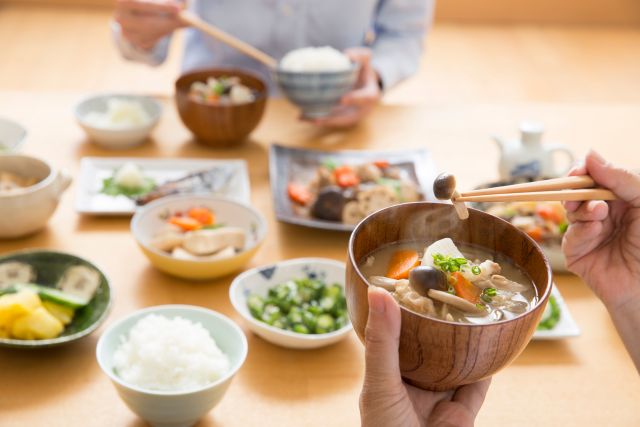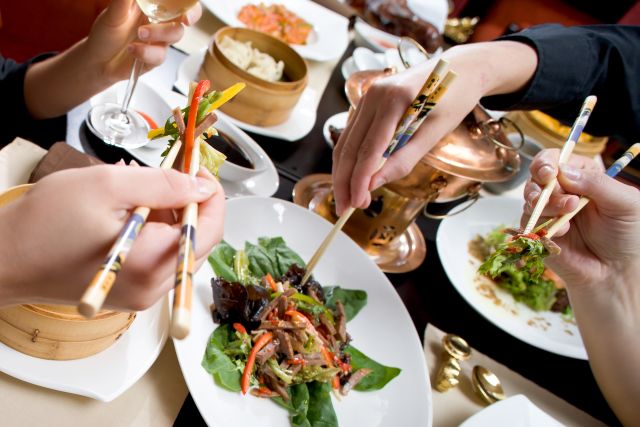Japanese culture is spangled with rich history and traditions. From shaking hands and bowing to eating and drinking, there’s proper etiquette for virtually all occasions in Japanese culture.
In this brief article, we’re going to shed light on the most important Japanese table manners and etiquette that you ought to follow next time you find yourself in a Japanese restaurant or around Japanese friends.
Don’t Lower Your Head to Eat
Whether you’re trying to drink from a bowl of miso soup or eat from a bowl of rice, you shouldn’t lower your head at all. If you’re trying to drink from a bowl of soup, it’s permitted to lift the bowl to your lips, according to miso soup etiquette.
If you’re trying to eat from a bowl of rice, on the other hand, you should lift the bowl up with one hand and scoop the rice into your mouth using the chopsticks in your other hand. Note that you can’t lift anything but a bowl of soup to your mouth.
Okay, so what about other foods that aren’t rice? Well, all you need to do is grab whatever it is you’re trying to eat with your chopsticks, place them in your bowl of rice, and then eat them.
Avoid Stabbing Your Food
When in a Japanese restaurant, you need to forget all about spoons and forks. The main utensil you’ll be using is the chopsticks. You shouldn’t use your chopsticks as if they’re a knife or a fork. Put differently, you can’t cut or stab your food with your chopsticks.
So how are you going to cut the food? You won’t have to. Japanese food is typically served in bite-sized chunks.
There are circumstances, however, where you may need to split a piece of food, such as when you’re trying to cut the last bite so that you can share it with someone who’s eating with you. In this situation, it’s acceptable to squeeze the chopsticks together around the bite until it splits.

Avoid Elbows on the Table
When in a Japanese restaurant or having a meal with Japanese acquaintances, you should not have your elbows on the table while eating because they worsen your posture. Good posture is critical in the Japanese culture, and having bad posture is simply against etiquette.
To ensure having good posture while eating, you must have your elbows raised. Alternately, it’s within proper Japanese table manners to eat while having your non-chopstick-holding hand on the table with other tableware.
Don’t Lick Your Chopsticks
Just as it is rude and unsavory to lick or suck on a spoon, fork, or knife, it’s also unpleasant to lick or suck on the chopsticks. It’s also worth mentioning that chopsticks shouldn’t be left in the mouth for the slightest second.
It also goes without saying that you should never play with your chopsticks. Don’t pretend that they’re drumsticks and try to kick the illest drum solo with them and don’t use them as fangs to pretend you’re a vampire.
Moreover, you should never ever use your chopsticks to point at people. Some rules are a bit flexible, but pointing or gesturing at people with your chopsticks isn’t one of these rules.
Implement Slurping Sounds
This is one of the Japanese table manners that are quite flexible and aren’t really mandatory, so don’t feel obligated to do it. Basically, when you’re having things like ramen, miso soup, udon, or tea, it’s a good practice to implement slurping sounds.
However, if you decide to go for this practice, you can’t go overboard with other sounds thinking they’re all okay. For example, you can’t make any chewing noises while eating. Moreover, when you attempt to put down tableware, you must do it slowly so that it doesn’t create notable noise.
No Chopstick-to-Chopstick Transfers
This is one table manner that you must always keep in mind and never attempt at all. Basically, in the Buddhist funeral ceremonies in Japan, the bones of the cremated dead body are picked with the aid of dedicated chopsticks and passed from one member of the family to another until they reach the urn.
If you attempt to pass food from chopstick to chopstick, it’ll be considered a violation of funeral customs and traditions that the Japanese hold sacred. You can’t even attempt to pick up a bite that another person has reached for at the same time.
If you feel the need to pass food to someone else, ask them politely to hand you their torizara (plate) so that you can pass the food. One thing you should keep in mind when trying to place food into someone’s plate using your chopsticks is that it could be viewed as unhygienic.
If you want to pass food into someone else’s place, we recommend using serving utensils. It’s also permitted to use the unused ends of your chopsticks to transfer food.
Also, keep in mind to use the blunt ends of your chopsticks that you’re not eating with to pick up food from a communal dish that you’re sharing with the people around the table.

Say Thank You Before and After
Showing gratitude is a pretty big deal in the Japanese culture, and one must pay their respects to the food they’re about to eat before and after eating. Before you eat your meal, you need to say “Itadakimasu,” and after you eat your meal, you must say “Gochiso-sama.”
The first phrase is used to pay respect to the people that have helped make this meal the way it is, from the people that have grown the ingredients to the ones that have cooked the food. The second phrase is used to pay respect to the food itself.
Eat All That You’ve Ordered
In Japanese culture, leftovers are viewed as disrespect to the food and the people that have worked hard to make it the way it is for you. To avoid leaving leftovers, make sure you order an amount that you’re able to finish.
Final Thoughts
Employing proper Japanese table manners and etiquette will ensure a pleasant food experience for you and the people around in a Japanese restaurant or around Japanese acquaintances, so make sure you keep the above-mentioned guidelines in mind.